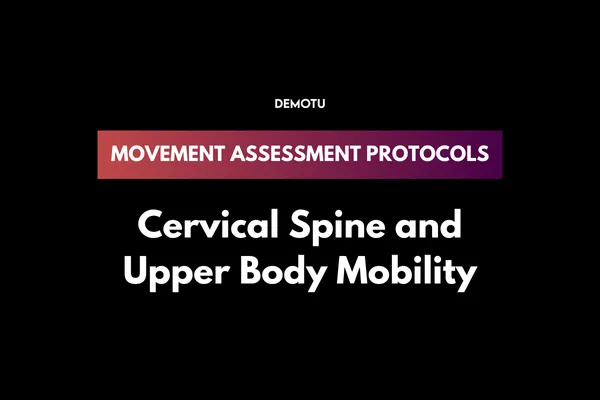
Cervical Spine and Upper Body Mobility Screen: Essential Protocol for Athletic Trainers
Movement Analysis, Workout Builder
In contact sports like football, cervical spine mobility and upper body stability play a crucial role in both performance and injury prevention. Restricted neck mobility can increase an athlete's risk for concussive injuries, while poor shoulder function may compromise stability and control. Demotu’s Cervical Spine and Upper Body Mobility Screen provides Athletic Trainers with a targeted assessment protocol to evaluate neck and shoulder function, helping to identify potential risks before they lead to injury.
This protocol offers Athletic Trainers a streamlined approach to assess and track the cervical spine and upper body stability, empowering athletes to perform at their best while minimizing the likelihood of injury.
Cervical Spine and Upper Body Mobility Screen Protocol
Functional Assessments
1. Push
Focus: Upper body strength and control
This test involves the athlete performing a basic push-up movement while maintaining proper form. The focus is on shoulder mobility and how well the athlete can stabilize their shoulders under load. Pay close attention to any asymmetry between the two shoulders, which can indicate a mobility issue or strength imbalance.
Joint Comparisons
Cervical Rotation: Assessing cervical rotation, or the athlete’s ability to turn their head side-to-side, is vital for detecting any restrictions or asymmetries in neck mobility. In contact sports, limited cervical rotation can increase susceptibility to injuries by reducing an athlete’s ability to move and react fluidly.
Cervical Flexion/Extension: Checking the range of motion in cervical flexion (chin to chest) and extension (looking upward) provides insight into the flexibility and control of the neck muscles. Restrictions here can indicate stiffness or imbalances, which may place additional strain on the spine and increase the risk of concussive impacts.
Shoulder Flexion: Evaluating shoulder flexion (raising the arms overhead) helps Athletic Trainers determine the athlete’s upper body flexibility, particularly in the shoulder girdle and thoracic spine. Poor shoulder flexion often indicates tightness in the upper back or shoulders, which can lead to compensatory patterns that impact athletic performance.
Shoulder External/Internal Rotation: Assessing both internal and external rotation of the shoulders is essential for identifying imbalances that can affect shoulder stability and increase injury risk. In contact sports, maintaining shoulder mobility and balanced muscle activation is crucial to prevent injuries, especially during overhead movements or physical collisions.
Research & Insights
Studies show that limited cervical spine mobility is a common factor linked to concussive risks in contact sports. Poor neck flexibility or stability can reduce an athlete’s ability to absorb and dissipate force, making them more vulnerable to head and neck injuries. By regularly evaluating cervical rotation and shoulder stability, Athletic Trainers can help mitigate these risks, improving athletes’ safety and resilience.
Moreover, shoulder rotation imbalances can indicate weaknesses in the rotator cuff or upper back, areas critical for upper body control and injury prevention. Addressing these imbalances is key for athletes who engage in high-speed collisions or repetitive overhead movements.
Supporting Injury Prevention Through Targeted Exercises
Demotu’s Cervical Spine and Upper Body Mobility Screen doesn’t stop at assessment; it offers tools for customized corrective exercises that address specific weaknesses identified during the evaluation. With the exercise builder and workout builder features, Athletic Trainers can create individualized plans to enhance both cervical and upper body mobility and strength.
Suggested Exercises:
For Cervical Rotation and Stability: Incorporate neck rotation exercises with resistance bands or isometric holds to build strength and range of motion. Chin tucks can also help strengthen deep neck flexors for better cervical stability.
For Shoulder Flexibility and Strength: Exercises like wall slides, shoulder external rotations, and scapular retractions can improve shoulder function, enhancing control and reducing the risk of upper body injuries.
For Upper Body Stability: Scapular stability exercises, such as scapular push-ups or plank variations, strengthen the shoulder girdle, improving overall control and endurance for contact or high-impact activities.
Demotu’s Tools for Athletic Trainers
Demotu’s platform empowers Athletic Trainers to monitor athletes’ cervical and shoulder health over time, offering data-driven insights that help prevent injuries before they occur. By tracking improvements in neck mobility, shoulder range of motion, and upper body control, you can ensure athletes maintain peak performance while minimizing injury risk.
The platform’s customizable assessment tools allow trainers to adapt protocols based on each athlete’s specific needs, making it easier to address issues as they arise. With built-in functionality to create personalized workout plans, you can deliver targeted conditioning programs that enhance both stability and flexibility.
Read about our other Upper Body Assessments:
Upper Body Overhead Athlete Screen: A Comprehensive Guide for Athletic Trainers
Click Here To Use Motion Capture for Movement Assessments - Free Today!